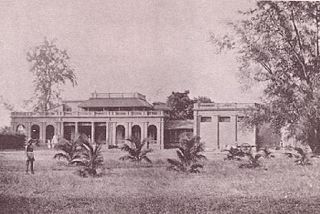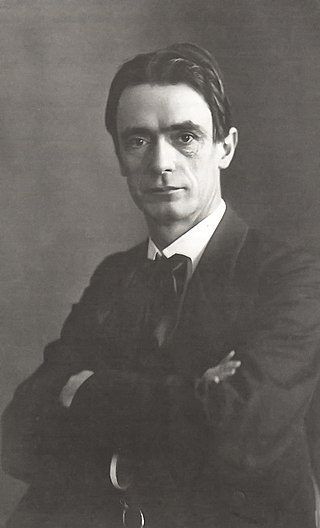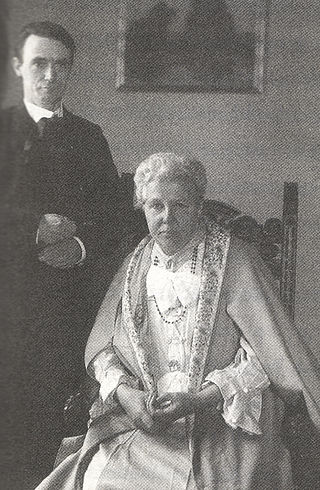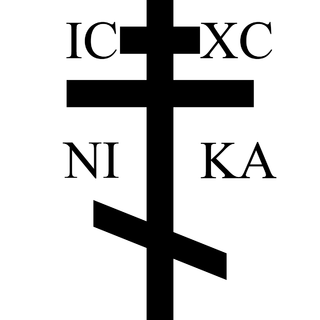
Jiddu Krishnamurti was an Indian philosopher, speaker, writer, and spiritual figure. Adopted by members of the Theosophical tradition as a child, he was raised to fill the advanced role of World Teacher, but in adulthood he rejected this mantle and distanced himself from the related religious movement. He spent the rest of his life speaking to groups and individuals around the world; many of these talks have been published. He also wrote many books, among them The First and Last Freedom (1954) and Commentaries on Living (1956–60). His last public talk was in January 1986, a month before his death at his home in Ojai, California.

The Theosophy Society was founded by Helena Petrovna Blavatsky and others in 1875. The designation 'Adyar' is sometimes added to the name to make it clear that this is the Theosophical Society headquartered there, after the American section and some other lodges separated from it in 1895, under William Quan Judge. In 1882, its headquarters moved with Blavatsky and president Henry Steel Olcott from New York to Adyar, an area of Chennai, India.

The Theosophical Society is the organizational body of Theosophy, an esoteric new religious movement. It was founded in New York City, U.S. in 1875. Among its founders were Helena Blavatsky, a Russian mystic and the principal thinker of the Theosophy movement, and Henry Steel Olcott, the society's first president. It draws upon a wide array of influences among them older European philosophies and movements such as Neoplatonism and occultism, as well as parts of Asian religious traditions such as Hinduism, Buddhism, and Islam.

Annie Besant was a British socialist, theosophist, freemason, women's rights and Home Rule activist, educationist, and campaigner for Indian nationalism. She was an ardent supporter of both Irish and Indian self-rule. She became the first female president of the Indian National Congress in 1917.

Charles Webster Leadbeater was a member of the Theosophical Society, Co-Freemasonry, an author on occult subjects, and the co-initiator, with J. I. Wedgwood, of the Liberal Catholic Church.

In the religion of Theosophy and the spiritual movement called Anthroposophy, the Akashic records are a compendium of all universal events, thoughts, words, emotions and intent ever to have occurred in the past, present, or future in terms of all entities and life forms, not just human. They are believed by theosophists to be encoded in a non-physical plane of existence known as the mental plane. Because it is believed that the records are encoded vibrationally into the inherent fabric of space, some have likened the mechanism as similar to how holograms are created. There is currently no scientific evidence for the existence of the Akashic records, and rigorous scientific research in this field has seen little traction.

Alfred Percy Sinnett was an English author and theosophist.
Djwal Khul, is believed by some Theosophists and others to be a Tibetan disciple in "The Ageless Wisdom" esoteric tradition. The texts describe him as a member of the 'Spiritual Hierarchy', or 'Brotherhood', of Mahatmas, one of the Masters of the Ancient Wisdom, defined as the spiritual guides of mankind and teachers of ancient cosmological, metaphysical, and esoteric principles that form the origin of all the world's great philosophies, mythologies and spiritual traditions. According to Theosophical writings, Djwal Khul is said to work on furthering the spiritual evolution of our planet through the teachings offered in the 24 books by Alice Bailey of Esoteric Teachings published by The Lucis Trust ; he is said to have telepathically transmitted the teachings to Bailey and is thus regarded by her followers as the communications director of the Masters of the Ancient Wisdom.

Morya, also spelt Maurya, is one of the "Masters of the Ancient Wisdom" within modern Theosophical beliefs. He is believed by followers of Theosophism to be one of the Mahatmas who inspired the founding of the Theosophical Society and was engaged in a correspondence with two English Theosophists living in India, A. P. Sinnett and A. O. Hume. The correspondence was published in 1923 by A. Trevor Barker, in the book The Mahatma Letters to A. P. Sinnett.

At the Feet of the Master is a book attributed to Jiddu Krishnamurti (1895–1986), authored when he was 14 years old. Written under the name Alcyone, it was first published in 1910. The work was closely related to the World Teacher Project, a contemporary messianic endeavor launched by the Theosophical Society. The book is considered a spiritual classic and was still in print in 2012. By that time it had been published in dozens of editions and had been translated in many languages; by 2004 early editions were in the public domain. Throughout its publication history the work has also generated controversy, regarding the author's identity.

Theosophical teachings have borrowed some concepts and terms from Buddhism. Some theosophists like Helena Blavatsky, Helena Roerich and Henry Steel Olcott also became Buddhists. Henry Steel Olcott helped shape the design of the Buddhist flag. Tibetan Buddhism was popularised in the West at first mainly by Theosophists including Evans-Wentz and Alexandra David-Neel.

Neo-Theosophy is a term, originally derogatory, used by the followers of Helena Blavatsky to denominate the system of Theosophical ideas expounded by Annie Besant and Charles Webster Leadbeater following the death of Madame Blavatsky in 1891. This material differed in major respects from Blavatsky's original presentation, but it is accepted as genuinely Theosophical by many Theosophists around the world.
Master Jesus is the theosophical concept of Jesus in theosophy and the Ascended Master Teachings.

The relationship between Rudolf Steiner and the Theosophical Society, co-founded in 1875 by H.P. Blavatsky with Henry Steel Olcott and others, was a complex and changing one. Rudolf Steiner founded the Anthroposophical Society on 28 December 1912, and he was expelled from the Theosophical Society on 7 March 1913.
The Order of the Star in the East (OSE) was an international organisation based at Benares (Varanasi), India, from 1911 to 1927. It was established by the leadership of the Theosophical Society at Adyar, Madras (Chennai) to prepare the world for the arrival of a reputed messianic entity, the World Teacher or Maitreya. The OSE acquired members worldwide as it expanded in many countries; a third of its diverse membership c. 1926 was unaffiliated with the Theosophical Society. The precursor of the OSE was the Order of the Rising Sun and the successor was the Order of the Star. The precursor organisation was formed after leading Theosophists discovered a likely candidate for the new messiah in the then–adolescent Jiddu Krishnamurti (1895–1986), a South Indian Brahmin who was installed as Head of the Order. Almost two decades later Krishnamurti rejected the messianic role, repudiated the Order's mission, and in 1929 disbanded the OSE's successor. The founding and activities of these organisations, as well as the largely unexpected dissolution of the OSE's successor, attracted widespread media attention and public interest. They also led to crises in the Theosophical Society and to schisms in Theosophy. Krishnamurti's later multi-decade career as a notable independent philosopher has been a factor in evaluations of the OSE and its mission.
The Great White Brotherhood, in belief systems akin to Theosophy and New Age, are said to be perfected beings of great power who spread spiritual teachings through selected humans. The members of the Brotherhood may be known as the Masters of the Ancient Wisdom, the Ascended Masters, the Church Invisible, or simply as the Hierarchy. The first person to talk about them in the West was Helena Petrovna Blavatsky (Theosophy), after she and other people claimed to have received messages from them. These included Helena Roerich, Alice A. Bailey, Guy Ballard, Geraldine Innocente, Elizabeth Clare Prophet, Bob Sanders, and Benjamin Creme.

Man: Whence, How and Whither, A Record of Clairvoyant Investigation, published in 1913, is a theosophical book compiled by the second president of the Theosophical Society (TS) - Adyar, Annie Besant, and by a TS member, Charles W. Leadbeater. The book is a study on early times on planetary chains, beginnings of early root races, early civilizations and empires, and past lives of men.

Theosophy is a religion established in the United States during the late 19th century. It was founded primarily by Helena Blavatsky and draws its teachings predominantly from Blavatsky's writings. Categorized by scholars of religion as both a new religious movement and as part of the occultist stream of Western esotericism, it draws upon both older European philosophies such as Neoplatonism and Indian originated religions such as Hinduism and Buddhism.

Christianity and Theosophy, for more than a hundred years, have had a "complex and sometimes troubled" relationship. The Christian faith was the native religion of the great majority of Western Theosophists, but many came to Theosophy through a process of opposition to Christianity. According to professor Robert S. Ellwood, "the whole matter has been a divisive issue within Theosophy."

Hinduism is regarded by modern Theosophy as one of the main sources of "esoteric wisdom" of the East. The Theosophical Society was created in a hope that Asian philosophical-religious ideas "could be integrated into a grand religious synthesis." Prof. Antoine Faivre wrote that "by its content and its inspiration" the Theosophical Society is greatly dependent on Eastern traditions, "especially Hindu; in this, it well reflects the cultural climate in which it was born." A Russian Indologist Alexander Senkevich noted that the concept of Helena Blavatsky's Theosophy was based on Hinduism. According to Encyclopedia of Hinduism, "Theosophy is basically a Western esoteric teaching, but it resonated with Hinduism at a variety of points."














